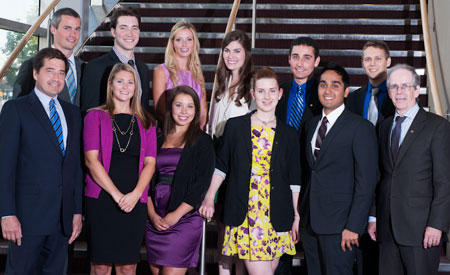 Première rangée (g. à dr.) : Dave Hancin, vice-président et directeur général, DENTSPLY Canada; Stephanie Smith, Université Dalhousie; Camille Ruel, Université Laval; Allison Nicholls, Université de la Colombie-Britannique; Jay Lalli, Université de la Saskatchewan; Dr Robert Sutherland, président de l’ADC. Deuxième rangée (g. à dr.) : Kristopher Scott Currie, Université de la Saskatchewan; Matthew Morrison, Université McGill; Patricia Brooks, École de médecine et de médecine dentaire Schulich; Janelle Hamilton, Université de Montréal; Stephen Spano, Université de Toronto; Matthew Kotyk, Université du Manitoba.
Première rangée (g. à dr.) : Dave Hancin, vice-président et directeur général, DENTSPLY Canada; Stephanie Smith, Université Dalhousie; Camille Ruel, Université Laval; Allison Nicholls, Université de la Colombie-Britannique; Jay Lalli, Université de la Saskatchewan; Dr Robert Sutherland, président de l’ADC. Deuxième rangée (g. à dr.) : Kristopher Scott Currie, Université de la Saskatchewan; Matthew Morrison, Université McGill; Patricia Brooks, École de médecine et de médecine dentaire Schulich; Janelle Hamilton, Université de Montréal; Stephen Spano, Université de Toronto; Matthew Kotyk, Université du Manitoba.
Le Programme de recherche des cliniciens étudiants ADC/DENTSPLY 2012 s’est tenu à Saskatoon lors du congrès annuel de l’ADC. Ce concours national de recherche clinique invite des étudiants des 10 facultés de médecine dentaire agréées du Canada à présenter devant des juges des démonstrations cliniques de leur travail de recherche.
Matthew Morrison, de l’Université McGill, a été élu gagnant du programme 2012 pour son étude cas-témoin portant sur le lien entre le torus buccal et les facteurs mécaniques et systémiques locaux. Son premier prix lui donne droit à un voyage tous frais compris au congrès annuel de l’Association dentaire américaine (ADA) 2012 à San Francisco, pour y présenter sa recherche dans le cadre du programme scientifique de l’ADA.
« Avoir l’occasion de discuter de ma recherche avec des professionnels dentaires a été une expérience des plus enrichissantes. Je me réjouis de présenter mon projet lors du congrès de l’ADA », dit le Dr Morrison. Dans le concours de cette année, Patricia Brooks de l’École de médecine et de médecine dentaire Schulich (Université Western). Ses travaux portaient sur l'intermodulation des voies de signalisation des ostéoblastes. « Le congrès a été une occasion remarquable de rencontrer d’autres cliniciens étudiants de partout au pays. Cette opportunité de réseautage avec des étudiants qui partagent une passion pour la recherche – qui se présente si tôt dans notre carrière – facilitera sans aucun doute les collaborations futures », explique-t-elle. Son prix consiste en une somme de 1000 $ versée par DENTSPLY.
Depuis plus de 40 ans, DENTSPLY commandite la Programme de recherche des cliniciens étudiants, qui a pour but « de susciter des idées, d’améliorer les communications et, par-dessous tout, d’accroître la participation des étudiants au progrès de la profession dentaire ».
La division canadienne de l’Académie Pierre Fauchard rend également hommage aux cliniciens étudiants qui participent au concours en leur présentant une bourse en reconnaissance des efforts déployés pour la promotion de l’éducation dentaire, indépendamment de leur carrière universitaire.
+++++
Le JADC a le plaisir de publier une version condensée des sommaires qui ont été présentés dans le cadre du Programme de recherche des cliniciens étudiants ADC/DENTSPLY 2012. Pour être admissible, le projet de recherche doit s’inscrire dans l’une des deux catégories suivantes : « applications et techniques cliniques » ou « science et recherche fondamentales ». Les étudiants doivent indiquer le but de leur étude, fournir des renseignements généraux, décrire brièvement la façon dont l’étude a été menée et présenter les résultats de l’étude et leur signification possible. Les candidats retenus sont choisis par leur faculté respective; ces candidats doivent poursuivre des études de premier cycle au moment de leur sélection. Neuf facultés de médecine dentaire ont participé au programme cette année.
Les sommaires sont publiés dans la langue de soumission.
1re place
Lien entre la formation de tori dans la cavité buccale et certains facteurs mécaniques locaux et facteurs systémiques : une étude cas-témoin
Par Matthew Morrison, Université McGill
Conseillère : Dr Faleh Tamimi
 Matthew Morrison
Matthew Morrison
Malgré la forte prévalence des tori dans la cavité buccale, on ne connaît encore aucun mécanisme établi qui puisse expliquer la formation de ces excroissances. Or la compréhension des processus intervenant dans la formation de tissus osseux ectopiques dans la cavité buccale – comme les tori – pourrait aider à mettre au point des méthodes moins invasives pour favoriser l’augmentation de la crête alvéolaire et l’amélioration naturelle de la qualité des os en vue de la mise en place d’implants dentaires. Des études récentes ont établi une corrélation entre, d’une part, le stress mécanique, un faible niveau d’hyperactivité du système immunitaire et la prise d’antihypertenseurs et, d’autre part, les altérations du métabolisme osseux qui favorisent l’apposition osseuse. Nous avons donc formulé l’hypothèse que des facteurs dentaires, des problèmes médicaux et des agents pharmacologiques connus pour stimuler la formation osseuse pourraient être associés à un risque accru de tori dans la cavité buccale.
Au moyen d’une étude cas-témoin, nous avons déterminé et établi un échantillon formé de cas (présence de torus palatin ou mandibulaire) et de témoins durant une période de 1,5 an. Les dossiers médicaux ont été obtenus et des données ont été colligées sur certains facteurs dentaires, les troubles de l’articulation temporo-mandibulaire (ATM), la prise de médicaments et les problèmes médicaux.
Nos résultats ont établi un lien indirect entre le bruxisme et la formation de tori buccaux. Nous avons également observé une forte corrélation entre les troubles de l’ATM et la présence de tori. Un lien significatif a aussi été établi entre la prise d’antihypertenseurs et la présence de tori palatins, ainsi qu’entre les sujets allergiques à la pénicilline (hyperactivité de faible niveau du système immunitaire) et la présence de tori mandibulaires. De façon générale, nos travaux ont démontré des liens entre la formation de tissus osseux ectopiques dans la cavité buccale et des facteurs mécaniques locaux, le système nerveux sympathique et le système immunitaire.
2e place
Intermodulation (cross-talk) entre la voie de signalisation Wnt/ß-caténine et celle des récepteurs nucléotidiques P2X7 dans les ostéoblastes
Par Patricia Brooks, École de médecine et de médecine dentaire Schulich, Université Western
Conseiller : Dr Jeff Dixon
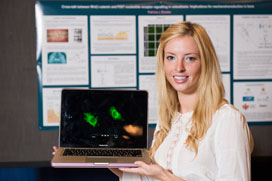 Patricia Brooks
Patricia Brooks
La voie de signalisation Wnt/ß-caténine et celle des récepteurs nucléotidiques P2X7 jouent un rôle important dans la formation osseuse et la méchanotransduction. Notre étude avait pour but d’examiner s’il pouvait y avoir intermodulation entre ces voies dans les ostéoblastes.
Des cellules de type ostéoblaste C3T3-E1 ont été traitées avec le ligand Wnt (Wnt3a) (ou avec le BzATP – un agoniste du récepteur P2X7 – pour les témoins), seuls ou en association. À différentes périodes entre 0 et 24 h, les échantillons ont été fixés, immunomarqués pour la ß-caténine et examinés par microscopie confocale. La localisation de la ß-caténine a été quantifiée pour servir d’indicateur de l’activation de la ß-caténine. Afin d’évaluer directement l’activité transcriptionnelle, les cellules ont été transfectées avec un plasmide rapporteur de la luciférase dépendant de la ß-caténine, puis traitées (Wnt3a ou BzATP).
La Wnt3a utilisée seule a provoqué une hausse graduelle de la localisation nucléaire de la ß-caténine, qui a culminé à 3 h et est revenue à sa valeur de départ après 24 h. À l’inverse, le BzATP a causé une localisation nucléaire transitoire seulement à 30 min. Il convient notamment de souligner que la localisation nucléaire de la ß-caténine a été plus rapide et plus soutenue dans les cellules traitées avec l’association Wnt3a-BzATP que dans celles traitées uniquement par la Wnt3a. De même, l’intensité de la localisation nucléaire a été beaucoup plus forte dans les cultures traitées par le mélange Wnt3a+BzATP que dans celles traitées uniquement par la Wnt3a. Le dosage de l’expression du gène rapporteur a révélé que le BzATP utilisé seul n’a pas augmenté l’activité transcriptionnelle de la ß-caténine; en revanche, l’association Wnt3a+BzATP a provoqué une augmentation de l’activité de la ß-caténine supérieure à celle observée uniquement avec la Wnt3a, ce qui indique que l’activation des récepteurs P2X7 stimule la voie Wnt/ß-caténine dans les ostéoblastes. Nous avons démontré pour la première fois dans un système que l’activation des récepteurs P2X7 prolonge et potentialise l’activité de la ß-caténine provoquée par la voie de signalisation Wnt, et démontré ainsi l’existence d’une intermodulation entre ces deux voies importantes. Ce phénomène pourrait stimuler la réaction anabolisante des os sous l’effet de la stimulation mécanique qui se produit durant l’ostéogenèse en distraction et le mouvement orthodontique des dents.
A retrospective study examining factors influencing patient compliance in a periodontal maintenance program and its influence on tooth loss and clinical attachment level
Par Janelle Hamilton, Université de Montréal
Conseillers : Drs Robert Durand anet René Voyer
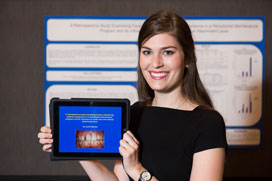 Janelle Hamilton
Janelle Hamilton
The aims of this retrospective study were to determine factors influencing patient compliance and whether patient compliance in a periodontal maintenance therapy (PMT) program influences tooth loss and clinical attachment level.
Data from 759 patients who were treated by a periodontist between 1969 and 2003 were reviewed. One hundred and twenty patients diagnosed with chronic periodontitis were included in this study. Subjects were at least 35 years old, underwent active periodontal therapy and were maintained for a minimum of 5 years. Patient-level risk factors and clinical parameters, including tooth loss throughout periodontal maintenance therapy, were collected. Data were analyzed to detect differences between complete and erratic compliers using 2 different compliance definitions (1 and 2) previously described in the literature.
There were no significant differences in patient-specific risk factors for periodontitis between complete and erratic compliers 2, except for bruxism (p = 0.005). There were no significant differences in the number of teeth lost in complete vs. erratic compliers 2 ( p= 0.65). Complete compliers 2 had significant improvements in mean pocket depths compared to erratic compliers 2 (p = 0.007). However, no differences in mean clinical attachment level change were found between the two groups (p = 0.16).
There were no differences in tooth loss between complete and erratic compliers enrolled in a PMT program. Although complete compliers exhibited higher mean pocket depth reduction, no significant differences were found for clinical attachment level. This study highlights the need for more prospective studies of PMT measuring patient compliance and clinical outcomes.
An investigation into bisphenol A (BPA) leaching from orthodontic materials
Par Matthew Kotyk, Université du Manitoba
Conseiller : Dr William Wiltshire
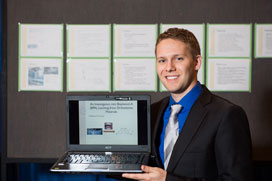 Matthew Kotyk
Matthew Kotyk
In clinical dentistry, numerous types of dental materials are in direct contact with oral tissues and oral fluids. The leaching of components from these dental materials could be a clinical concern. Within resin composite and plastic materials, a leached component of particular interest is bisphenol A (BPA) due to its cytotoxic and estrogenic properties. This study investigated BPA leaching from orthodontic materials including, but not limited to, clear aligners when subjected to the most extreme conditions experienced intra-orally, including thermal shock and abrasion.
As-received orthodontic materials used in routine orthodontic treatment were obtained from the manufacturers, with one exception. All materials were subjected to vigorous thermal and physical conditions to identify if those conditions would be responsible for stimulating BPA release. The standard leaching conditions consisted of initial surface abrasion followed by immersion in a medium of artificial saliva, followed by thermal shock treatment involving temperature cycling from hot to cold with shaking for 5 minutes at each temperature and repeated for a total of 10 cycles. The samples were then shaken at normal oral temperature and aliquots removed at regular time intervals. All aliquots were analyzed for BPA.
The conditions to which the orthodontic materials were subjected in this study represent the extremes of those encountered intra-orally. For some materials, no BPA release was detected and the concerns with regards to those materials are alleviated. Conversely, the discovery of BPA leaching from some materials will necessitate a review of their use.
The effect of back fitness on changes in muscle activation and fatigue after performing a dental procedure
Par Jay Lalli et Kristopher Scott Currie, Université de la Saskatchewan
Conseillère : Dre Carol Lynn Nagle
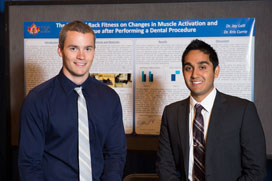 Kristopher Scott Currie et Jay Lalli
Kristopher Scott Currie et Jay Lalli
Dental professionals are prone to back muscle injuries due to the inherent occupational stresses within the profession. Our main objective was to determine whether dental students with low back fitness experience greater muscle fatigue and strain compared to students with high back fitness, while the secondary objective was to gain insight into the factors that may play a role.
Twenty-nine dental students consented to participate in this study. Students completed the Waterloo Handedness Questionnaire, Physical Activity Readiness Questionnaire and the Canadian Society for Exercise Physiology back fitness test, which established their back fitness score. Participants were attached to an electromyogram (EMG) and baseline readings of the erector spinae were established. The participants performed a 15-minute tooth preparation, with recordings before and after the procedure, as well as a maximal voluntary contraction reading. Muscle activation and median EMG frequency were compared between participants with high and low scores.
Participants with low back fitness scores displayed increased EMG activity before and after the procedure when compared to those with high back fitness, indicating overall greater strain on the erector spinae. The lower back fitness group experienced a decreasing median frequency, indicating increased muscle fatigue. Participants with low back fitness scores experience greater muscle strain and fatigue of the erector spinae during dental procedures. Dentists should take an active role in preventing back strain and fatigue, such as exercises that improve muscular endurance and reduce waist girth, to ensure healthier careers in dentistry.
Kinetic characterization of a novel class of anticollagenase catK inhibitors
Par Allison Nicholls, Université de la Colombie-Britannique
Conseiller : Dr Ravindra Shah
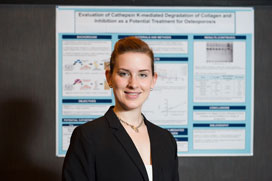 Allison Nicholls
Allison Nicholls
Osteoporosis is a bone degenerative disease caused by excessive osteoclast activity. Cathepsin K is a cysteine protease that is highly expressed in osteoclasts. This enzyme forms a complex with chondroitin 4-sulphate (C4-S) creating collagenase activity. The objective of the research was to determine the kinetic parameters of collagen hydrolysis by cathepsin K and to evaluate the potency of previously identified cathepsin K/C4-S complex formation inhibitors.
Km and kcat values were determined for the degradation of type-I collagen by the cathepsin K/C4-S complex. Michalis-Menten kinetics and a Lineweaver-Burk analysis were used to evaluate the data. Structurally-related putative cathepsin K/C4-S complex formation inhibitors were evaluated for their ability to prevent cathepsin K/C4-S-mediated degradation of collagen in a non-active site inhibitory mechanism. An IC50 was determined for each effective compound, and the accessibility of the active site of cathepsin K was determined using a synthetic fluorogenic peptide substrate, Z-FR-MCA.
The kinetic values for cathepsin K/C4-S-mediated degradation of collagen are as follows: Km = 1.6 mM, kcat = 6 h-1 and kcat/Km = 1.062 M-1s-1. Six out of the 8 putative cathepsin K inhibitors were able to prevent the degradation of collagen: aurintricarboxylic acid (IC50 = 9.6 μM); ellipticine (IC50 = ~100 μM); epigallocatechin gallate (IC50 = 52 μM); raloxifene (IC50 = 85 μM); suramin (IC50 = 6.7 μM); and tamoxifen (IC50 = ~150 μM). All but suramin appeared to be non-active site inhibitors. Interestingly, tamoxifen and raloxifene have been clinically demonstrated to inhibit bone resorption via an estrogen-related pathway.
L’effet des diètes molles sur la guérison tissulaire gingivale après une chirurgie buccale : une étude in vitro
Par Camille Ruel, Université Laval
Conseillère : Dre Lise Payant
 Camille Ruel
Camille Ruel
L’objectif général était d’analyser l’impact positif ou négatif de certains aliments présents dans les diètes molles sur le processus de guérison tissulaire gingivale et d’identifier un moyen pour favoriser la cicatrisation d’une lésion buccale à la suite d’une chirurgie, sans pour autant affecter les conditions de vie normale du patient. Les résultats obtenus permettront donc d’améliorer les recommandations formulées aux patients à la suite d’une intervention chirurgicale.
Trois aliments ont été testés sur des cellules gingivales humaines (épithéliales et fibroblastes) : un jus d’orange, un substitut de repas ainsi qu’un yogourt à boire. Trois types d’expérimentation ont été réalisés afin de pouvoir analyser les effets des produits sur la migration, la prolifération et la différenciation cellulaire, et ce, à différents pH. Soit la première série d’expériences aux pH normaux des différentes solutions et la seconde série à des pH normalisés à 6,8.
Les résultats obtenus montrent en général que seul le substitut de repas ne semble pas nuire à ces 2 phénomènes lorsque les produits ne sont pas modifiés. Il a été également déterminé que le pH des aliments influence grandement leur effet nocif sur les cellules gingivales. Donc, une première recommandation serait de ne pas consommer d’aliments acides lors de la diète molle prescrite après une chirurgie buccale. Il ne va sans dire que plusieurs autres tests devront être réalisés avant de vraiment pouvoir transposer ces résultats in vivo et obtenir de cette recherche un usage clinique pour les professionnels du domaine dentaire.
Current choices for all ceramic restorations: evidence-based review with clinical guidelines for material selection
Par Stephanie Smith, Université Dalhousie
Conseiller : Dr Mark Vallee
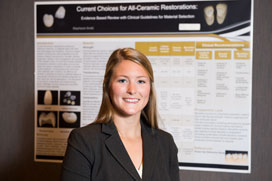 Stephanie Smith
Stephanie Smith
Currently, there is an expansive selection of all ceramic materials; however, none encompass the ideal properties of strength and esthetic appropriate for all clinical situations. Therefore, the purpose of this research project is to provide relevant comparisons between current glass and zirconia based all-ceramics, as well as provide clinical recommendations for material use.
A literature review was completed with the PubMed database including the search terms “ceramics,” “dental porcelain,” “leucite,” “lithium disilicate,” and “zirconia.”
Searches were limited to clinical trials, meta-analyses, randomized control trials and papers written in English.
Research revealed that zirconia based all-ceramics exhibit high flexural strength and fracture toughness, but are limited by their translucent and therefore esthetic properties. Alternatively, glass-based ceramics exhibit high translucency but have weaker physical properties of strength and fracture toughness. These variations in material properties influence which all-ceramic is appropriate for differing clinical applications. Due to their increased esthetic properties but weaker clinical strength, glass-based ceramics have been recommended for in lays/on lays, anterior and posterior single crowns, and anterior fixed partial dentures (FPDs). Zirconia coping restorations combine superior mechanical properties with esthetic overlying porcelain, therefore these materials are recommended for anterior and posterior single crowns and FPDs, as well as locations to conceal an underlying restoration. Finally, single layered monolithic zirconia is recommended for posterior single crowns and FPDs, areas of parafunction, limited interarch space and locations to conceal underlying restorations.
Role of discoidin domain receptor 1 in cyclosporine A-induced gingival overgrowth
Par Stephen Spano, Université de Toronto
Conseiller : Dr Christopher McCulloch
 Stephen Spano
Stephen Spano
Gingival overgrowth is an adverse outcome of cyclosporine A (CsA) treatment, involving disruption of collagen remodeling. Fibroblast receptors that mediate remodelling and that are dysregulated by CsA are not defined. We hypothesized that discoidin domain receptor 1 (DDR1) expressed by fibroblast is important for collagen remodeling and that DDR1 is affected by CsA, thereby disrupting collagen homeostatis.
Our objectives were to (1) determine whether DDR1 mediates collagen remodeling by fibroblasts; (2) assess the effets of CsA on DDR1-mediated collagen remodeling.
Mouse 3T3 fibroblast cells expressing DDR1 or null for DDR1 were treated with vehicle (dimethyl sulfoxide-DMSO) or CsA (1 µM in DMSO). Cells were inoculated into floating or attached collagen gels to study the role of DDR1 in fibrillar reorganization or cell-mediated traction, respectively. Cell migration was analyzed with in vitro scratch wound assays.
DDR1-expressing cells contracted floating gels more rapidly than DDR1 null cells (mean slope±S.E.M.: DDR1=75.4±12.2 µm/hr; DDR1 null cells=18.9±4.8 µm/hr; p < 0.001). DDR1-expressing cells treated with CsA exhibited a 2.2-fold reduction of gel contraction (34.4±2.3 µm/hr; p < 0.001). CsA has no effect on DDR1 null cells (p > 0.0.5). In attached collagen gel concentration assays, DDR1-expressing cells contracted gels more rapidly than DDR1 null cells (877±63 µm/hr vs. 247±87 µm/hr; p < 0.001). CsA did not affect attached gel concentration. DDR1 expression and CsA did not affect cell migration in scratch wound assays (p > 0.0.5).
DDR1 is important for collagen remodeling by fibrillar reorganization and by contraction in vitro, but CsA only affects fibrillar reorganization. Accordingly, CsA perturbation of DDR1-mediated fibrillar reorganization may contribute to gingival overgrowth.
Photos : Teckles Photo Inc.
